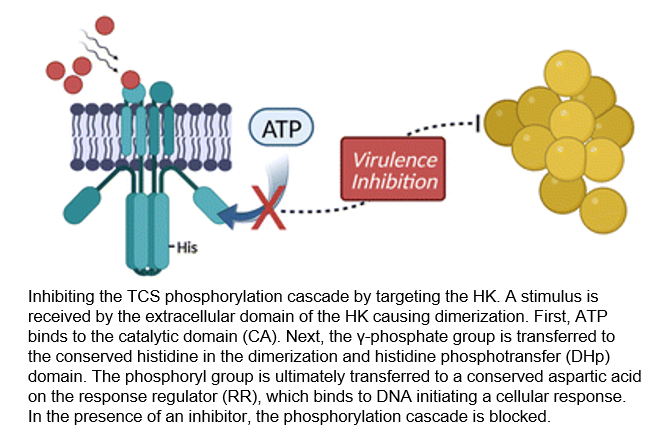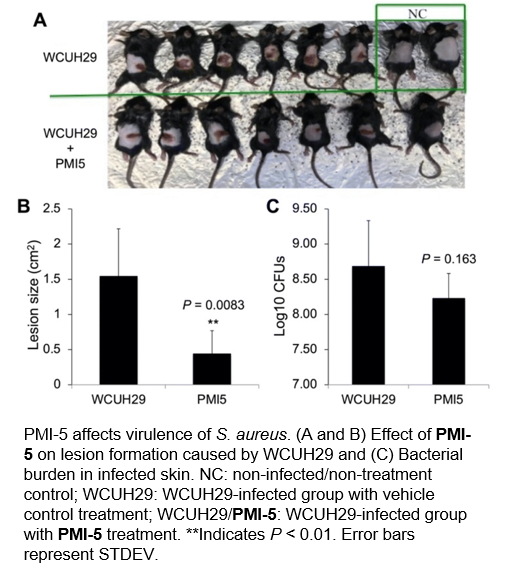Bacterial histidine kinase inhibitors for treating Staphylococcus infections
Small molecule bacterial histidine kinase inhibitors that significantly diminish staphylococcal virulence.


Applications
- Anti-virulence agent
- Antibiotic adjuvant
- Research tool
Key Benefits & Differentiators
- Potential for lowering antibiotic resistance: PMI compounds act as anti-virulence agents, potentially reducing the evolutionary pressure for bacteria to develop resistance mechanisms.
- In vivo efficacy: PMI-5 exhibited promising results in a mouse model of Staphylococcus aureus skin infection, reducing bacterial lesion size and burden.
- Adjuvant or standalone therapy: These compounds could be used as adjuvants alongside existing antibiotics, enhancing their effectiveness, or as standalone therapies.
Technology Overview
The emergence of drug-resistant bacteria, such as methicillin-resistant Staphylococcus aureus (MRSA), which are not susceptible to current antibiotics has necessitated the development of novel approaches and targets to tackle this growing challenge. Bacterial two-component systems play a central role in the adaptive response of bacteria to their ever-changing environment. They are linked to antibiotic resistance and bacterial virulence making the proteins of the TCSs, histidine kinases (HKs), and response regulators, attractive for the development of novel antibacterial drugs.
Researchers at the University of Minnesota have developed maleimide-based compounds, PMI-1–20, which were evaluated for potency in vitro and in silico. Compounds that inhibited HK autophosphorylation and disrupted bacterial signaling emerged as promising leads. These leads were further examined for their ability to impede Staphylococcus aureus (S. aureus) virulence. PMI-1, 2, 3, and 5 showed efficacy in reducing staphylococcal hemolytic activity and were then assessed through cytotoxicity assays using A549 cells. PMI-5, chosen because it had no cytotoxic effect on A549 cells, demonstrated a 25% decrease in staphylococcal invasion of A549 cells. In a mouse model of S. aureus skin infection, PMI-5 significantly reduced bacterial lesion size by 65% and slightly decreased bacterial burden in the infected skin by 10%. Taken together, these data support that PMI-5 shows promise for diminishing bacterial virulence in vivo. Importantly, these compounds function as anti-virulence agents, potentially lowering the evolutionary pressure for bacterial resistance. These compounds could serve as adjuvants with existing antibiotics or as standalone therapies, enhancing the immune response against bacterial infections.
Phase of Development
TRL: 3-4Through in vitro and in vivo testing, PMI-5 was identified as the lead compound having no cytotoxic effect on human cells and showing promise for diminishing bacterial virulence in vivo.
Desired Partnerships
This technology is now available for:- License
- Sponsored research
- Co-development
Please contact our office to share your business’ needs and learn more.
Researchers
- Erin E. Carlson, PhD Smith Professor of Chemistry, Department of Chemistry
- Yinduo Ji , MS, PhD Professor, Department of Veterinary and Biomedical Sciences
- Junshu Yang Researcher 3, Department of Veterinary and Biomedical Sciences
-
expand_more library_books References (1)
- Adeline Espinasse, Manibarsha Goswami, Junshu Yang, Onanong Vorasin, Yinduo Ji, and Erin E. Carlson (2023), Targeting multidrug resistant Staphylococcus infections with bacterial histidine kinase inhibitors, Chemical Science, Issue 19
-
expand_more cloud_download Supporting documents (1)Product brochureBacterial histidine kinase inhibitors for treating Staphylococcus infections.pdf